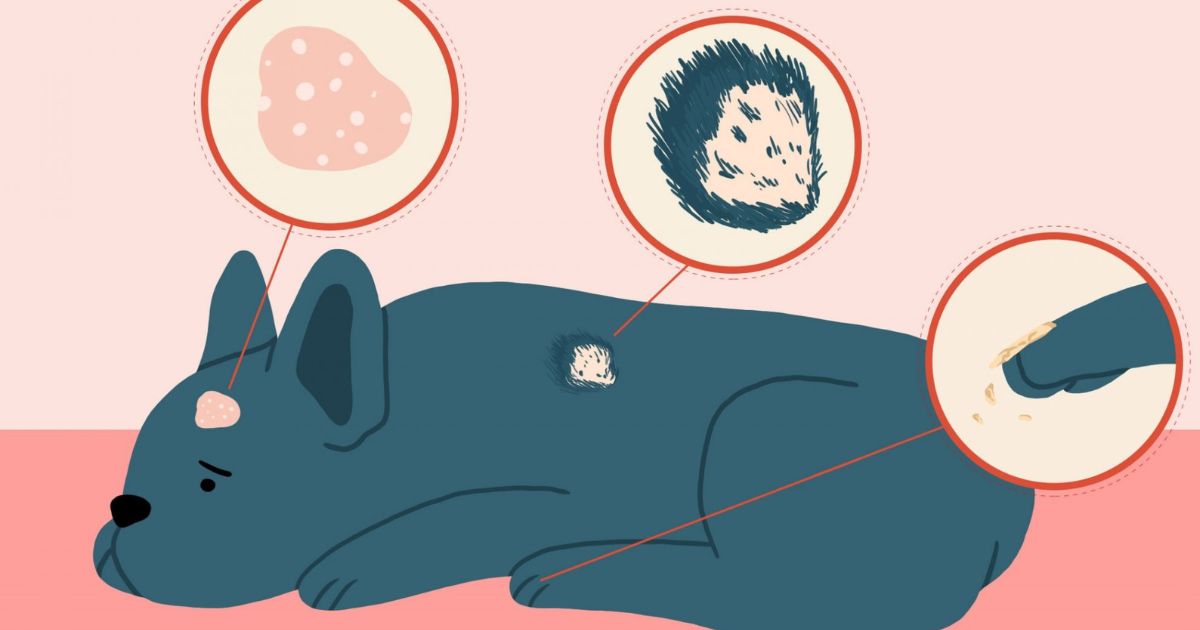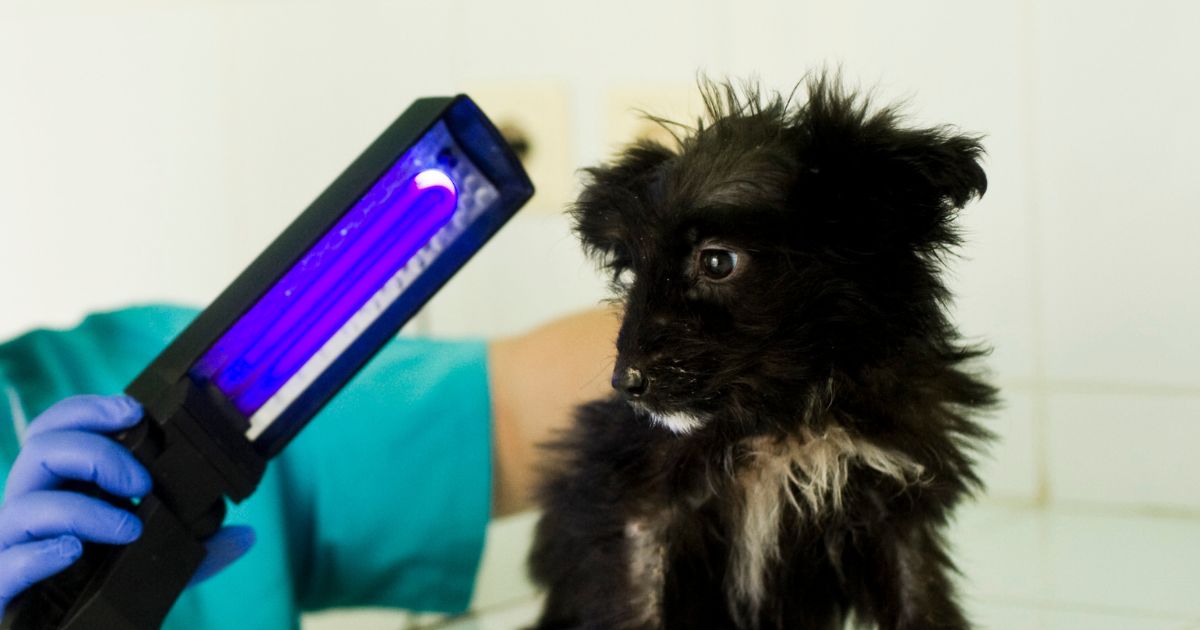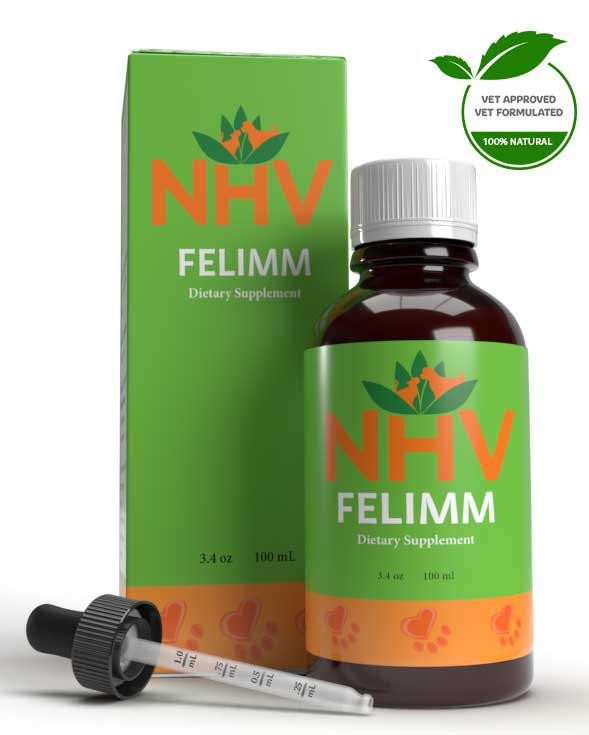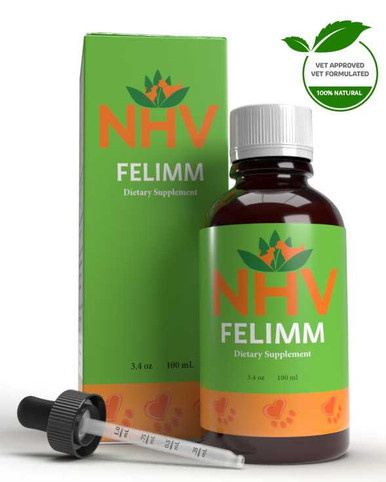medicinal mushroom blend

free shipping over $100 (USA & Canada)
1-877-937-4372 the pet expert hotline

Ringworm is the common name for a fungal infection that affects superficial layers of hair, skin, and nails. It is common in all domesticated animals, like dogs and cats, and can be transmitted from animal to human and vice versa. It is called ringworm due to the appearance of the lesion, which is often ring-shaped and red but not always, so the name is a little misleading. The infection is also not caused by a worm.
Ringworm is caused by a group of fungi known as dermatophytes. The disease is medically referred to as dermatophytosis. The most common dermatophytes that affect dogs are Microsporum canis, Microsporum gypseum, and Trichophyton mentagrophytes, which can also be transmitted to humans.
Ringworm in dogs often affects the hair follicles, causing them to break – this is when the skin gets infected and the ring lesion forms. If not treated, the fungi multiply, and the lesion can become irregularly shaped and spread over the dog’s body.
Some clinical signs are
Because the lesions are itchy, it is easy for the fungi to spread to the snout and nails. In the nails, the infection is called onychomycosis and causes the claws to become rough, brittle, and broken.
While some dogs will present all symptoms, others can present only one or no symptoms at all. These are called “asymptomatic carriers”, as they don’t develop any clinical signs, but they can carry the fungi and spread it to other animals and humans. This is especially problematic if the infected dog lives somewhere like a kennel or a shelter.
Ringworm is highly transmissible by direct contact with infected animals, or by indirect contact, like touching bowls, brushes, bedding, or carpet that were used by infected animals. The fungus can remain dormant for over 18 months in the environment, which makes this type of skin infection particularly hard to get rid of.
Once infected, a dog may take seven to fourteen days to show any lesions. Some cases take up to 21 days before any signs develop. Others, like mentioned, can be asymptomatic carriers that spread the infection to other animals and humans.

There are three ways to reach a diagnosis for ringworm in dogs. A veterinarian can choose one or more of these methods.
Cytology is when the veterinarian collects a few hair samples and possibly a scrape of the affected skin for analysis under a microscope. This method is not super accurate as the collected sample may not show the fungus and the disease can be misdiagnosed.

Wood’s Lamp is a quick test where the Veterinarian examines the hair and skin of the dog under ultraviolet light. Most cases of M. canis fungi will glow with a yellow-green fluorescence when observed in a dark room with ultraviolet light. However, M. canis doesn’t always glow. M. gypseum and T. mentagrophytes do not glow under a Wood’s Lamp. Although this method is acceptable, it is not always very reliable to diagnose ringworm.
Culture is the preferred and most reliable method of diagnosis for ringworm in dogs. A culture can be confirmed as fast as a couple of days in some cases. However, a culture cannot be regarded as negative for at least a month, as some cultures may be slower to grow.
Because there are multiple kinds of ringworm that can cause alopecia in dogs, a veterinarian is the most qualified person to examine your dog and rule out any other cause.
Most veterinarians opt to treat ringworm on dogs with a combination of topical (antifungal sprays and ointments) and oral (antifungal drugs) treatments. Both treatments must be given for the dosage period that the veterinarian prescribes. Also, the environment must be decontaminated to prevent reinfections.
Do not stop any treatment prescribed by your veterinarian, as it can cause the infection to reoccur.
As mentioned, ringworm in cats is one skin disease that is hard to get rid of. Because it is highly transmissible by direct and indirect contact.
Once cat ringworm is diagnosed, the infected pet must be isolated from other animals in the household and from humans. Ideally, beds, carpets, and bowls must be replaced. If this is not possible, they must be thoroughly cleaned. The environment must also be cleaned properly.
Nature’s Immuno – A blend of mushrooms with extensive health benefits. Helps support the immune response, and may also help the body fight ringworm infections.
Stimmune – May help to reduce symptoms like itchiness while also strengthening the immune system and helping the body fight off ringworm infections.
All Clear Ointment: Helps with skin issues like dry skin, scaly patches that look like dandruff, large brown flakes, crusty scabs, blisters, and pimples. It may help with redness and inflammation of the skin, as well as with itchy skin problems, and may help with symptoms like excessive licking and chewing of the skin.
Ouch Away spray – Helps soothe and heal irritated skin, may help stimulate hair regrowth, and helps a weakened immune system.
Felimm – A supplement with powerful antifungal properties, it can help the immune system fight off fungal infections, and stimulate the appetite.
medicinal mushroom blend

Vet-Formulated Supplement of Medicinal Mushrooms for Dogs
buy 2 and save $3
3 month supply for a small to medium size pet
Natures Immuno is formulated for dogs from Turkey Tail, Cordyceps, Reishi, Shiitake, and Agaricus mushrooms by a holistic veterinarian and master herbalist. Medicinal mushrooms like these have been used for thousands of years in Chinese medicine as well as traditional herbalism. Researchers around the globe are now studying their potential in helping with cancer, balancing the immune system, and helping with digestive problems and more.


Natures Immuno is formulated for dogs from Turkey Tail, Cordyceps, Reishi, Shiitake, and Agaricus mushrooms by a holistic veterinarian and master herbalist. Medicinal mushrooms like these have been used for thousands of years in Chinese medicine as well as traditional herbalism. Researchers around the globe are now studying their potential in helping with cancer, balancing the immune system, and helping with digestive problems and more.

Natures Immuno Medicinal Mushroom blend for dogs also helps:
Medicinal mushrooms and mushroom extracts are used worldwide to help fight cancer and to help enhance and modulate the immune response of both people and animals. NHV’s mushroom blend contains 5 species of medicinal mushrooms for dogs, which have a long history of use, are well studied, and have been credited with having success against cancer as well as having antioxidant, hypocholesterolemia, anti-tumor, immunomodulatory, anti-allergic, nephroprotective, prebiotic, immunostimulant, anti-inflammatory, cardiovascular, and anti-diabetic properties
Properties of these Medicinal Mushrooms
Benefits of Natures Immuno Medicinal Mushrooms Blend for Dogs
You can read more about medicinal mushrooms for dogs and how they help give added support to pets for cancer and immunity.
NHV carries a wide range of holistic, natural vet-approved remedies that provide support along with a vet-recommended treatment plan. If you have questions about any of our plant-based supplements, ask an NHV expert, because, at NHV, we want your pet to live healthier and longer naturally.

Turkey Tail mushroom is native to Asia, North America, and Europe. It has a long history of use in traditional herbalism and is currently being studied for its health benefits, including its value in fighting cancer. Research has shown that Turkey Tail is beneficial for many types of cancer as it contains properties that help fight cancer cells while helping to strengthen the immune system. Turkey tail mushroom for dogs has shown to be beneficial in spleen and liver hemangiosarcoma in dogs. It is also useful for heart health, lowering cholesterol, digestive issues, and skin problems.
Cordyceps mushroom is very rich in phytonutrients. Research has indicated that these mushrooms demonstrate anti-tumor, immune enhancing and hypoglycemic activity. It has anti-inflammatory, antioxidant, anti-tumor, anti-cancer, antimetastatic, and antiviral properties. It is very useful for diabetes as it helps lower blood sugar. Cordyceps also help enhance lymphocyte activity, which balance the immune system.
Reishi mushroom has been used for thousands of years in traditional Chinese medicine. It helps detoxify the blood, helps lower cholesterol and reduces blood pressure. It is also beneficial for the lymphatic system, which helps with a dog’s immunity.
Shiitake mushroom is a popular ingredient in cooking and is highly valued in traditional herbalism for its immune stimulating properties. It helps reduce fat in the liver, helps lower cholesterol, and is beneficial for heart health as it aids in reducing plaque in the arteries. Shiitake may help inhibit the growth of leukemia cells. Shiitake is also a good source of protein, vitamins, and minerals.
Agaricus mushroom is cultivated widely for dietary supplements and culinary purposes. Agaricus is useful for bone health, and helps with insulin production and helps with liver function. Agaricus is considered an adaptogen, which helps combat stress and supports the endocrine functions. This mushroom is currently used in Japan as an adjunctive with chemotherapy treatments.
Select your pet's weight to determine the correct dose.
To be taken twice daily.
Determine your pet’s weight and then use the easy chart below to determine the correct dose. You can safely double the recommended dosage.
Pet's Weight Dosage
0 - 15 lb 0.5 mL
16 - 30 lb 1.0 mL
31 - 45 lb 1.5 mL
46 - 60 lb 2.0 mL
61 - 75 lb 2.5 mL
Over 75 lb 3.0 mL
For small animals (rabbits, ferrets), avians and reptiles use 1 drop for every 2 lb of body weight.
How to Administer
Shake well before use. The easiest method is to use the dropper provided and place the drops into your pet’s food or favorite treat. You can also use the dropper and squirt directly into the pet’s mouth. Some pets can be finicky, if this occurs consider hiding the drops in foods most pet’s love such as fish, chicken, yogurt, or a favorite treat. If your pet only eats dry food then soak a few kibbles at feeding time.
For Best Results
Herbal dietary supplements are beneficial to the health and well-being of your pet and are safe for long-term use. Every pet responds to natural herbal supplements differently, therefore it is important to be consistent and administer the product daily. Supplements generally take two to four weeks to take effect, however this will vary from one animal to the next.
Product Storage
All NHV Natural Pet Products are pure herbal extracts and contain no artificial additives, preservatives or coloring. Shelf life after opening is 6 months and must be refrigerated after opening.
Natures Immuno Medicinal Mushroom blend for dogs also helps:
Medicinal mushrooms and mushroom extracts are used worldwide to help fight cancer and to help enhance and modulate the immune response of both people and animals. NHV’s mushroom blend contains 5 species of medicinal mushrooms for dogs, which have a long history of use, are well studied, and have been credited with having success against cancer as well as having antioxidant, hypocholesterolemia, anti-tumor, immunomodulatory, anti-allergic, nephroprotective, prebiotic, immunostimulant, anti-inflammatory, cardiovascular, and anti-diabetic properties
Properties of these Medicinal Mushrooms
Benefits of Natures Immuno Medicinal Mushrooms Blend for Dogs
You can read more about medicinal mushrooms for dogs and how they help give added support to pets for cancer and immunity.
NHV carries a wide range of holistic, natural vet-approved remedies that provide support along with a vet-recommended treatment plan. If you have questions about any of our plant-based supplements, ask an NHV expert, because, at NHV, we want your pet to live healthier and longer naturally.

Turkey Tail mushroom is native to Asia, North America, and Europe. It has a long history of use in traditional herbalism and is currently being studied for its health benefits, including its value in fighting cancer. Research has shown that Turkey Tail is beneficial for many types of cancer as it contains properties that help fight cancer cells while helping to strengthen the immune system. Turkey tail mushroom for dogs has shown to be beneficial in spleen and liver hemangiosarcoma in dogs. It is also useful for heart health, lowering cholesterol, digestive issues, and skin problems.
Cordyceps mushroom is very rich in phytonutrients. Research has indicated that these mushrooms demonstrate anti-tumor, immune enhancing and hypoglycemic activity. It has anti-inflammatory, antioxidant, anti-tumor, anti-cancer, antimetastatic, and antiviral properties. It is very useful for diabetes as it helps lower blood sugar. Cordyceps also help enhance lymphocyte activity, which balance the immune system.
Reishi mushroom has been used for thousands of years in traditional Chinese medicine. It helps detoxify the blood, helps lower cholesterol and reduces blood pressure. It is also beneficial for the lymphatic system, which helps with a dog’s immunity.
Shiitake mushroom is a popular ingredient in cooking and is highly valued in traditional herbalism for its immune stimulating properties. It helps reduce fat in the liver, helps lower cholesterol, and is beneficial for heart health as it aids in reducing plaque in the arteries. Shiitake may help inhibit the growth of leukemia cells. Shiitake is also a good source of protein, vitamins, and minerals.
Agaricus mushroom is cultivated widely for dietary supplements and culinary purposes. Agaricus is useful for bone health, and helps with insulin production and helps with liver function. Agaricus is considered an adaptogen, which helps combat stress and supports the endocrine functions. This mushroom is currently used in Japan as an adjunctive with chemotherapy treatments.
Select your pet's weight to determine the correct dose.
To be taken twice daily.
Determine your pet’s weight and then use the easy chart below to determine the correct dose. You can safely double the recommended dosage.
Pet's Weight Dosage
0 - 15 lb 0.5 mL
16 - 30 lb 1.0 mL
31 - 45 lb 1.5 mL
46 - 60 lb 2.0 mL
61 - 75 lb 2.5 mL
Over 75 lb 3.0 mL
For small animals (rabbits, ferrets), avians and reptiles use 1 drop for every 2 lb of body weight.
How to Administer
Shake well before use. The easiest method is to use the dropper provided and place the drops into your pet’s food or favorite treat. You can also use the dropper and squirt directly into the pet’s mouth. Some pets can be finicky, if this occurs consider hiding the drops in foods most pet’s love such as fish, chicken, yogurt, or a favorite treat. If your pet only eats dry food then soak a few kibbles at feeding time.
For Best Results
Herbal dietary supplements are beneficial to the health and well-being of your pet and are safe for long-term use. Every pet responds to natural herbal supplements differently, therefore it is important to be consistent and administer the product daily. Supplements generally take two to four weeks to take effect, however this will vary from one animal to the next.
Product Storage
All NHV Natural Pet Products are pure herbal extracts and contain no artificial additives, preservatives or coloring. Shelf life after opening is 6 months and must be refrigerated after opening.
immune & allergy support

Natural Dog Food Allergy Supplement and Immune Support.
buy 2 and save $3
3 month supply for a small to medium size
Soothes food allergies, skin allergies (dermatitis), and infection. Helps relieve a variety of symptoms related to allergies. Supports a healthy balance of the immune system in pets with conditions such as autoimmune disease.

Soothes food allergies, skin allergies (dermatitis), and infection. Helps relieve a variety of symptoms related to allergies. Supports a healthy balance of the immune system in pets with conditions such as autoimmune disease.
Stimmune helps balance the immune system and helps ease allergy symptoms that can make your dog miserable. Stimmune is an all-natural, vet-formulated dog allergy immune supplement that will help your pet deal with dog food allergies as well as other immune related disorders.
Stimmune can provide dog allergy help with allergic reactions related to food, as well as environmental allergies including reactions to fleas, insect bites, food and other environmental factors. For more acute seasonal or environmental allergies, please try Alge-Ex for a remedy specifically formulated for your dog.
An allergy is an overreaction of the immune system to a normally harmless substance called an antigen. Allergies in dogs often occur when allergens are inhaled, ingested, or absorbed by the body. When this occurs, the immune system becomes over-reactive to substances it believes are harmful. This reaction causes a release of histamine, causing the common allergy symptoms in your pet.
The cause of allergies in dogs can be difficult to determine. While it is always best to eliminate the cause altogether, like omitting a specific food from their diet, some causes can be nearly impossible to totally eradicate, like dust mites or pollen. This is where a dog allergy supplement that is taken daily can help relieve your loved one of common allergens, even when you're not exactly sure what they are allergic to.
Dog food allergy support is close at hand with Stimmune added into your pet’s daily regimen. This 100% natural herbal supplement was formulated by a holistic veterinarian to comprehensively care for your pet’s health.
Explore our Pet Expert Q&A to ask questions about your pet’s allergic reactions or view questions that other concerned pet owners like you have posted. Or, visit our blog to learn how to prevent food allergies in dogs and cats.

Astragalus – Stimulates liver function and helps balance the immune system. High in antioxidants it also helps protect against oxidative damage.
Echinacea Purpurea – Reduces inflammation, helps boost the immune system and efficiently fights infection.
Oregon Grape – Has antibiotic, anti-inflammatory and immunostimulatory properties.
Asian Ginseng – Has been used for thousands of years to help against various health issues. This antioxidant herb helps balance the immune system, helps the body fight infections and helps the body cope against stress.
Myrrh – An astringent that relieves irritated skin, Myrrh is high in anti-inflammatory and antioxidant effects.
Select your pet's weight to determine the correct dose.
To be taken twice daily. Determine your pet’s weight and then use the easy chart below to determine the correct dose. This is the minimum dosage.
Pet's Weight Dosage
0 - 15 lb = 0.5 ml
16 - 30 lb = 1.0 ml
31 - 45 lb = 1.5 ml
46 - 60 lb = 2.0 ml
61 - 75 lb = 2.5 ml
Over 75 lb = 3.0 ml
For small animals (rabbits, ferrets), avians and reptiles use 1 drop for every 2 lb of body weight.
How to Administer
Shake well before use. The easiest method is to use the dropper provide and places the drops into your pet’s food or favorite treat. You can also use the dropper and squirt directly into the pet’s mouth.
Some pets can be finicky, if this occurs consider hiding the drops in foods most pet’s love such as fish, chicken or yogurt or a favorite treat. If your pet only eats dry food then soak a few kibbles at feeding time.
For Best Results
Herbal dietary supplements are beneficial to the health and wellbeing of your pet and are safe for long-term use. Every pet responds to natural herbal supplements differently, therefore it is important to be consistent and administer the product daily. Supplements generally take two to four weeks to take effect, however this will vary from one animal to the next.
Product Storage
All NHV Natural Pet Products are pure herbal extracts and contain no artificial additives, preservatives or coloring. Shelf life after opening is 6 months and must be refrigerated after opening.
Cautions and Contraindications
Do not use Stimmune in pregnant or nursing animals. Speak to your vet before using our products. A second visit is recommended if your pet’s condition does not improve, or deteriorates after continued use of the supplements.
All information provided by NHV Natural Pet Products is for educational purposes only.
Stimmune helps balance the immune system and helps ease allergy symptoms that can make your dog miserable. Stimmune is an all-natural, vet-formulated dog allergy immune supplement that will help your pet deal with dog food allergies as well as other immune related disorders.
Stimmune can provide dog allergy help with allergic reactions related to food, as well as environmental allergies including reactions to fleas, insect bites, food and other environmental factors. For more acute seasonal or environmental allergies, please try Alge-Ex for a remedy specifically formulated for your dog.
An allergy is an overreaction of the immune system to a normally harmless substance called an antigen. Allergies in dogs often occur when allergens are inhaled, ingested, or absorbed by the body. When this occurs, the immune system becomes over-reactive to substances it believes are harmful. This reaction causes a release of histamine, causing the common allergy symptoms in your pet.
The cause of allergies in dogs can be difficult to determine. While it is always best to eliminate the cause altogether, like omitting a specific food from their diet, some causes can be nearly impossible to totally eradicate, like dust mites or pollen. This is where a dog allergy supplement that is taken daily can help relieve your loved one of common allergens, even when you're not exactly sure what they are allergic to.
Dog food allergy support is close at hand with Stimmune added into your pet’s daily regimen. This 100% natural herbal supplement was formulated by a holistic veterinarian to comprehensively care for your pet’s health.
Explore our Pet Expert Q&A to ask questions about your pet’s allergic reactions or view questions that other concerned pet owners like you have posted. Or, visit our blog to learn how to prevent food allergies in dogs and cats.

Astragalus – Stimulates liver function and helps balance the immune system. High in antioxidants it also helps protect against oxidative damage.
Echinacea Purpurea – Reduces inflammation, helps boost the immune system and efficiently fights infection.
Oregon Grape – Has antibiotic, anti-inflammatory and immunostimulatory properties.
Asian Ginseng – Has been used for thousands of years to help against various health issues. This antioxidant herb helps balance the immune system, helps the body fight infections and helps the body cope against stress.
Myrrh – An astringent that relieves irritated skin, Myrrh is high in anti-inflammatory and antioxidant effects.
Select your pet's weight to determine the correct dose.
To be taken twice daily. Determine your pet’s weight and then use the easy chart below to determine the correct dose. This is the minimum dosage.
Pet's Weight Dosage
0 - 15 lb = 0.5 ml
16 - 30 lb = 1.0 ml
31 - 45 lb = 1.5 ml
46 - 60 lb = 2.0 ml
61 - 75 lb = 2.5 ml
Over 75 lb = 3.0 ml
For small animals (rabbits, ferrets), avians and reptiles use 1 drop for every 2 lb of body weight.
How to Administer
Shake well before use. The easiest method is to use the dropper provide and places the drops into your pet’s food or favorite treat. You can also use the dropper and squirt directly into the pet’s mouth.
Some pets can be finicky, if this occurs consider hiding the drops in foods most pet’s love such as fish, chicken or yogurt or a favorite treat. If your pet only eats dry food then soak a few kibbles at feeding time.
For Best Results
Herbal dietary supplements are beneficial to the health and wellbeing of your pet and are safe for long-term use. Every pet responds to natural herbal supplements differently, therefore it is important to be consistent and administer the product daily. Supplements generally take two to four weeks to take effect, however this will vary from one animal to the next.
Product Storage
All NHV Natural Pet Products are pure herbal extracts and contain no artificial additives, preservatives or coloring. Shelf life after opening is 6 months and must be refrigerated after opening.
Cautions and Contraindications
Do not use Stimmune in pregnant or nursing animals. Speak to your vet before using our products. A second visit is recommended if your pet’s condition does not improve, or deteriorates after continued use of the supplements.
All information provided by NHV Natural Pet Products is for educational purposes only.
immune support

Natural herbal supplement to help your dog fight many viral, fungal, and bacterial related infections.
buy 2 and save $3
3 month supply for a small to medium size pet.
Felimm is formulated with powerful, yet gentle herbs that are known for their antioxidant and anti-inflammatory properties to help your pup fight a variety of fungal and viral infections. This infection remedy for dogs helps combat Canine Herpesvirus, Canine Influenza, Lyme disease, Staphylococcal Bacterial, Ehrlichiosis, Aspergillosis, Blastomycosis Cryptococcus, Valley Fever, and yeast infections.


Felimm is formulated with powerful, yet gentle herbs that are known for their antioxidant and anti-inflammatory properties to help your pup fight a variety of fungal and viral infections. This infection remedy for dogs helps combat Canine Herpesvirus, Canine Influenza, Lyme disease, Staphylococcal Bacterial, Ehrlichiosis, Aspergillosis, Blastomycosis Cryptococcus, Valley Fever, and yeast infections.

Dogs can get viral, fungal, and bacterial infections of many kinds. Canine herpesvirus, Canine influenza, Lyme disease, Staphylococcal bacterial, Ehrlichiosis, Aspergillosis, Blastomycosis Cryptococcus, Valley Fever, and yeast infections just to name a few. Felimm is a natural vet-formulated remedy that helps support your dog’s body and helps them fight back against all of these conditions. Add Felimm canine infection remedy to the regimen prescribed by your vet to give them the most comprehensive possible care.
Felimm is an infection remedy for dogs with many ingredients that have strong antiviral properties. Turmeric, Aloe Vera, St. John’s Wort, and Myrrh have antiseptic, antibacterial, antiviral, and anti-inflammatory qualities that help make Felimm a powerful remedy to support your dog against a variety of conditions.
Viruses, as well as fungal and bacterial infections, can harm your dog’s immune system and affect the function of other organs. Some of these viruses, such as canine herpesvirus (CHV) or canine influenza virus, affect the respiratory and reproductive system. Felimm is also an excellent support supplement for pets fighting lymphoma.
To help your pet heal, it is important to support the affected organs and balance their immune system. NHV Felimm contains a variety of potent herbs that help support and defend the body against viral, fungal, and bacterial infections while boosting the immune system and detoxifying the lymph nodes.
NHV Felimm can help with Lyme disease in dogs and cats - a bacterial infection transmitted by ticks. This dog infection remedy can also help with Cryptococcus, a fungal infection caused by environmental yeast.
NHV’s holistic pet products contain human-grade herbal ingredients. All of our supplements are vet-approved and specially formulated by a veterinarian and master herbalist with over 20 years of experience.
Call the NHV pet expert hotline at 1-877-937-4327 to learn about our dog infection treatment aids.
St. John’s Wort – A herb known to have strong antiviral, immunostimulant, anti-inflammatory, antiretroviral and antibacterial properties. St. John’s Wort has a history of use to help the body fight the herpes virus, as well as viral hepatitis and HIV. It helps with inhibiting the reproduction of the viruses and has been shown to be beneficial for canine distemper.
Turmeric – A very powerful antioxidant that helps combat the damaging effects of free radicals. It strengthens liver function and contains strong antifungal properties.
Aloe Vera – Helps control fungal infections, and helps improve white blood cell counts which helps destroy infectious organisms. An herb that is known for its immunostimulating, antibacterial, antitumor, and anti-inflammatory properties.
Alfalfa – An extremely nutritious herb that is high in minerals, amino acids, a good source of chlorophyll, and high in antioxidants.
Burdock – Is an herb and a food that is very nutritive as it contains high levels of minerals such as iron and calcium. Strong antiviral properties support the liver and gallbladder, and help clean and improve the quality of blood. It helps remove toxins that accumulate during illness and helps scavenge free radicals from a dog’s body.
Cat’s Claw – Has traditionally been used in herbal medicine to treat the herpes virus and other related viral infections due to properties that help balance the immune system while fighting off infections and inflammation.
Osha – Used for centuries to help fight viral infections that affect the respiratory system. It helps to relieve inflammation of the bronchial tube, relax the muscles, and stops bacteria and viruses from spreading. A natural immune builder that helps dogs fight infections and helps improve immune function.
Dandelion – A highly nutritious food that stimulates liver secretion, protects the kidneys, improves digestion, and stimulates appetite. It helps provide a pet’s body with the vitamins and minerals needed when fighting an infection. It is known to help reduce inflammation.
Gotu Kola – An antioxidant-rich herb known to strengthen the immune system and protect cells from damage caused by free radicals. It helps calm the nervous system to reduce the added stress canines exhibit when fighting infections. It is also used to help with respiratory issues.
Usnea – An immune system stimulant with antibacterial and antifungal properties that helps protect a dog’s suppressed immune system from respiratory and sinus infections, bronchial issues, canine influenza, and herpes virus. It helps boost and restore proper immune function.
Goldenseal – An herb known for improving immune function. It helps eliminate toxins from the blood. It has strong fungal fighting properties and is used when dealing with Candida and thrush in dogs.
Myrrh – a medicinal herb that dates back to 1550 BC. Considered to be a natural antibiotic, antiviral, and astringent herb. It strengthens and improves the immune system and helps fight infections.
Select your pet's weight to determine the correct dose.
To be taken twice daily. Determine your pet’s weight and then use the easy chart below to determine the correct dose. This is the minimum dosage.
Pet's Weight Dosage
0 - 15 lb = 0.5 ml
16 - 30 lb = 1.0 ml
31 - 45 lb = 1.5 ml
46 - 60 lb = 2.0 ml
61 - 75 lb = 2.5 ml
Over 75 lb = 3.0 ml
How to Administer
Shake well before use. The easiest method is to use the dropper provided and place the drops into your pet’s food or favorite treat. You can also use the dropper and squirt directly into the pet’s mouth. Some pets can be finicky, if this occurs consider hiding the drops in foods most pet’s love such as fish, chicken or yogurt or a favorite treat. If your pet only eats dry food then soak a few kibbles at feeding time.
For Best Results
Herbal dietary supplements are beneficial to the health and well-being of your pet and are safe for long-term use. Every pet responds to natural herbal supplements differently, therefore it is important to be consistent and administer the product daily. Supplements generally take two to four weeks to take effect, however this will vary from one animal to the next.
Product Storage
All NHV Natural Pet Products are pure herbal extracts and contain no artificial additives, preservatives or coloring. Shelf life after opening is 6 months and must be refrigerated after opening.
Cautions and Contraindications
Do not use Felimm in pregnant or nursing animals. Speak to your vet before using our products. A second visit is recommended if your pet’s condition does not improve, or deteriorates after continued use of the supplements.
All information provided by NHV Natural Pet Products is for educational purposes only.
Dogs can get viral, fungal, and bacterial infections of many kinds. Canine herpesvirus, Canine influenza, Lyme disease, Staphylococcal bacterial, Ehrlichiosis, Aspergillosis, Blastomycosis Cryptococcus, Valley Fever, and yeast infections just to name a few. Felimm is a natural vet-formulated remedy that helps support your dog’s body and helps them fight back against all of these conditions. Add Felimm canine infection remedy to the regimen prescribed by your vet to give them the most comprehensive possible care.
Felimm is an infection remedy for dogs with many ingredients that have strong antiviral properties. Turmeric, Aloe Vera, St. John’s Wort, and Myrrh have antiseptic, antibacterial, antiviral, and anti-inflammatory qualities that help make Felimm a powerful remedy to support your dog against a variety of conditions.
Viruses, as well as fungal and bacterial infections, can harm your dog’s immune system and affect the function of other organs. Some of these viruses, such as canine herpesvirus (CHV) or canine influenza virus, affect the respiratory and reproductive system. Felimm is also an excellent support supplement for pets fighting lymphoma.
To help your pet heal, it is important to support the affected organs and balance their immune system. NHV Felimm contains a variety of potent herbs that help support and defend the body against viral, fungal, and bacterial infections while boosting the immune system and detoxifying the lymph nodes.
NHV Felimm can help with Lyme disease in dogs and cats - a bacterial infection transmitted by ticks. This dog infection remedy can also help with Cryptococcus, a fungal infection caused by environmental yeast.
NHV’s holistic pet products contain human-grade herbal ingredients. All of our supplements are vet-approved and specially formulated by a veterinarian and master herbalist with over 20 years of experience.
Call the NHV pet expert hotline at 1-877-937-4327 to learn about our dog infection treatment aids.
St. John’s Wort – A herb known to have strong antiviral, immunostimulant, anti-inflammatory, antiretroviral and antibacterial properties. St. John’s Wort has a history of use to help the body fight the herpes virus, as well as viral hepatitis and HIV. It helps with inhibiting the reproduction of the viruses and has been shown to be beneficial for canine distemper.
Turmeric – A very powerful antioxidant that helps combat the damaging effects of free radicals. It strengthens liver function and contains strong antifungal properties.
Aloe Vera – Helps control fungal infections, and helps improve white blood cell counts which helps destroy infectious organisms. An herb that is known for its immunostimulating, antibacterial, antitumor, and anti-inflammatory properties.
Alfalfa – An extremely nutritious herb that is high in minerals, amino acids, a good source of chlorophyll, and high in antioxidants.
Burdock – Is an herb and a food that is very nutritive as it contains high levels of minerals such as iron and calcium. Strong antiviral properties support the liver and gallbladder, and help clean and improve the quality of blood. It helps remove toxins that accumulate during illness and helps scavenge free radicals from a dog’s body.
Cat’s Claw – Has traditionally been used in herbal medicine to treat the herpes virus and other related viral infections due to properties that help balance the immune system while fighting off infections and inflammation.
Osha – Used for centuries to help fight viral infections that affect the respiratory system. It helps to relieve inflammation of the bronchial tube, relax the muscles, and stops bacteria and viruses from spreading. A natural immune builder that helps dogs fight infections and helps improve immune function.
Dandelion – A highly nutritious food that stimulates liver secretion, protects the kidneys, improves digestion, and stimulates appetite. It helps provide a pet’s body with the vitamins and minerals needed when fighting an infection. It is known to help reduce inflammation.
Gotu Kola – An antioxidant-rich herb known to strengthen the immune system and protect cells from damage caused by free radicals. It helps calm the nervous system to reduce the added stress canines exhibit when fighting infections. It is also used to help with respiratory issues.
Usnea – An immune system stimulant with antibacterial and antifungal properties that helps protect a dog’s suppressed immune system from respiratory and sinus infections, bronchial issues, canine influenza, and herpes virus. It helps boost and restore proper immune function.
Goldenseal – An herb known for improving immune function. It helps eliminate toxins from the blood. It has strong fungal fighting properties and is used when dealing with Candida and thrush in dogs.
Myrrh – a medicinal herb that dates back to 1550 BC. Considered to be a natural antibiotic, antiviral, and astringent herb. It strengthens and improves the immune system and helps fight infections.
Select your pet's weight to determine the correct dose.
To be taken twice daily. Determine your pet’s weight and then use the easy chart below to determine the correct dose. This is the minimum dosage.
Pet's Weight Dosage
0 - 15 lb = 0.5 ml
16 - 30 lb = 1.0 ml
31 - 45 lb = 1.5 ml
46 - 60 lb = 2.0 ml
61 - 75 lb = 2.5 ml
Over 75 lb = 3.0 ml
How to Administer
Shake well before use. The easiest method is to use the dropper provided and place the drops into your pet’s food or favorite treat. You can also use the dropper and squirt directly into the pet’s mouth. Some pets can be finicky, if this occurs consider hiding the drops in foods most pet’s love such as fish, chicken or yogurt or a favorite treat. If your pet only eats dry food then soak a few kibbles at feeding time.
For Best Results
Herbal dietary supplements are beneficial to the health and well-being of your pet and are safe for long-term use. Every pet responds to natural herbal supplements differently, therefore it is important to be consistent and administer the product daily. Supplements generally take two to four weeks to take effect, however this will vary from one animal to the next.
Product Storage
All NHV Natural Pet Products are pure herbal extracts and contain no artificial additives, preservatives or coloring. Shelf life after opening is 6 months and must be refrigerated after opening.
Cautions and Contraindications
Do not use Felimm in pregnant or nursing animals. Speak to your vet before using our products. A second visit is recommended if your pet’s condition does not improve, or deteriorates after continued use of the supplements.
All information provided by NHV Natural Pet Products is for educational purposes only.